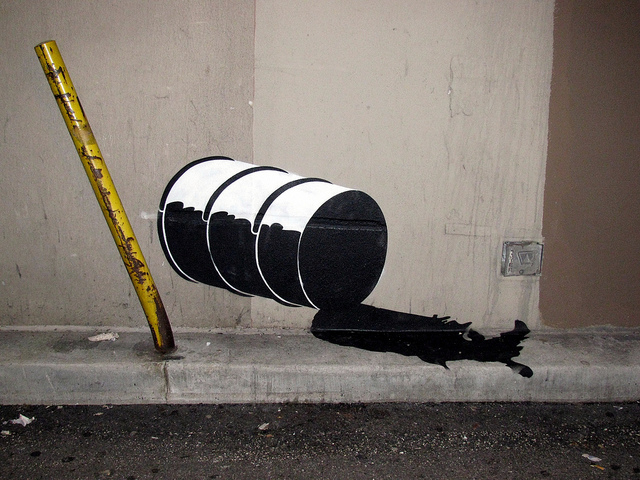There has been a recent flurry of news articles about the falling price of oil.
That’s because for the past several years the global price of oil has been relatively stable at about $110 a barrel. But recently Brent Crude (which is extracted from the North Sea and is the leading global price benchmark for Atlantic basin crude oils) and West Texas Intermediate (the benchmark price for North American oil refined mostly in the Midwest and Gulf Coast regions) fell to about $85 a barrel. Just two weeks ago, Western Canadian Select (the price of heavy crude extracted from the tar sands) dropped to about $76 a barrel from a previous year to date high of $87 a barrel.
The reasons for this price drop have been attributed to increased shale oil production in the United States (and the resulting sharp reduction of oil imports into that country), reduced demand in Europe and Asia due to their sluggish economies (further contributing to excess supply), and Saudi Arabia slightly increasing their production and cutting oil prices in Asia (arguably to maintain market share). The impact for Canada of falling oil prices have largely been reported as meaning a possible $3 billion shortfall in projected revenue for the Harper government, a growing vacancy rate for office space in Calgary, and a potential major hit to the Alberta economy given energy makes up about 25 per cent of their Gross Domestic Product.
Falling oil prices may also have a major impact on tar sands expansion, pipeline development, and even shipping bitumen on the St. Lawrence River.
Jeffrey Rubin notes, “Falling prices hit high-cost producers first and hardest. Guess what’s happening in the oil sands right now? In the last several months alone we’ve seen two major announcements of shelved or cancelled projects. Total SA is walking away from its Pierre River project, while Norway’s Statoil is doing the same from the Corner mine.”
And as the price of oil drops closer to the break-even point of $65-70 a barrel for tar sands production, so does the viability of pipelines. For example, the Keystone XL pipeline is a $5.3 billion project and the cost to producers of moving bitumen from Alberta to the Gulf Coast by pipeline is about $8 a barrel.
Rubin highlights, “Part of the impetus behind constructing new pipelines to carry bitumen from northern Alberta to the U.S. Gulf Coast [Keystone XL], Kitimat on the Pacific [the $7.9 billion Northern Gateway pipeline], or even all the way across the country to Saint John, N.B. [the $12 billion Energy East pipeline], was to help close the substantial discount between Canadian oil and world prices. …For pipeline companies with major proposals on the table, such as TransCanada and Enbridge, falling oil prices are a game-changer of the same magnitude that rising prices were a decade ago. Back then, soaring prices created an urgent need to build new pipelines to connect North America’s burgeoning supply to coastal refineries and world markets. We’re now in a different world.”
It would appear that the falling price of oil will also impact the transport of bitumen on the St. Lawrence River.
Just three weeks ago, the Minerva Gloria supertanker departed Sorel-Tracy (near Montreal) with 700,000 barrels of tar sands bitumen on board destined for a refinery in Sardinia, Italy. And the tanker Genmar Daphne is expected to depart soon with a similar sized load reportedly for the U.S. Gulf Coast. The plan was for 20 to 30 supertankers to do this every year.
But a market source has said further shipments are unlikely in the current price environment. That’s because transporting the crude by rail from Alberta to Sorel-Tracy costs about $12 a barrel and then shipping from the East Coast to the Gulf Coast by tanker costs another $2 a barrel.
MarineLink.com reported, “Shrinking differentials between Western Canada Select heavy blend and U.S. crude futures mean netbacks — the price received by producers minus the cost of getting the product to market — have been severely squeezed. The market source said the deal [to ship crude by tanker to the Gulf Coast] was set up several months ago when the economics made more sense.” And if the break-even point for tar sands bitumen is $65-70 a barrel, and it costs $14 to ship it this way, a global price of $85 a barrel doesn’t make this a viable option for now.
This all said, Bank of Montreal economist Robert Kavcic argues that the price of oil would have to sink below $80 a barrel for a sustained period of time to cause a substantial slowdown in the tar sands. He believes the price will settle at around $90 a barrel.
And the economics of moving oil on water remain worrisome.
U.S.-based Calumet Specialty Products had envisioned moving 400-foot-long barges on the Great Lakes, each carry 118,000 barrels of tar sands bitumen. The bitumen could be shipped by Line 67 to Superior, Wisconsin on the western tip of Lake Superior and from there onto the Great Lakes. Calumet had calculated that it would cost $3.50 a barrel to ship oil on the Great Lakes compared to moving it by rail at $9.00 a barrel.
These are dangerous equations for people, lakes, rivers and the climate.
Photo: Eric B./flickr




